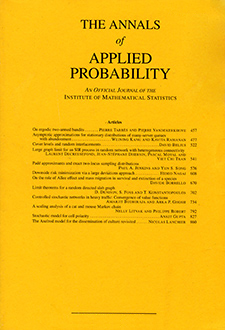Abstract
Throughput sub-optimality (TSO), introduced in Atar and Shaikhet [Ann. Appl. Probab. 19 (2009) 521–555] for static fluid models of parallel queueing networks, corresponds to the existence of a resource allocation, under which the total service rate becomes greater than the total arrival rate. As shown in Atar, Mandelbaum and Shaikhet [Ann. Appl. Probab. 16 (2006) 1764–1804] and Atar and Shaikhet (2009), in the many server Halfin–Whitt regime, TSO implies null controllability (NC), the existence of a routing policy under which, for every finite $T$, the measure of the set of times prior to $T$, at which at least one customer is in the buffer, converges to zero in probability at the scaling limit. The present paper investigates the question whether the converse relation is also true and TSO is both sufficient and necessary for the NC behavior.
In what follows we do get the affirmation for systems with either two customer classes (and possibly more service pools) or vice-versa and state a condition on the underlying static fluid model that allows the extension of the result to general structures.
Citation
Gennady Shaikhet. "Necessary condition for null controllability in many-server heavy traffic." Ann. Appl. Probab. 25 (1) 406 - 428, February 2015. https://doi.org/10.1214/13-AAP1001
Information





